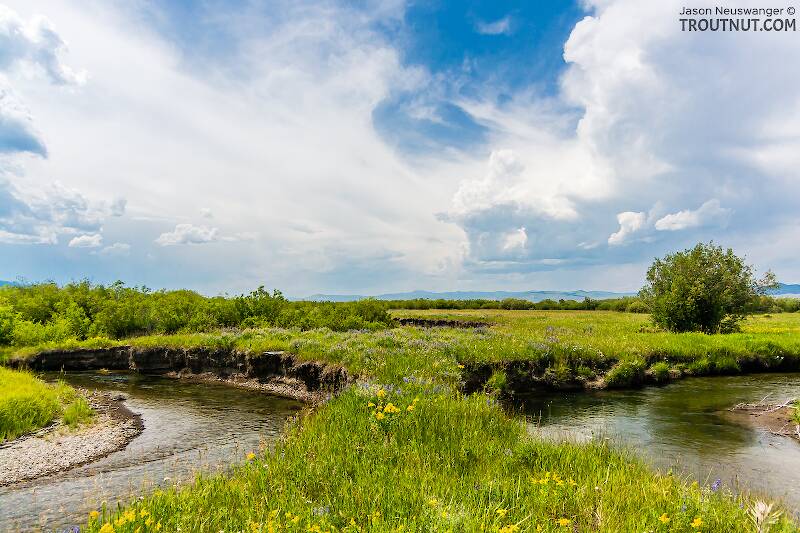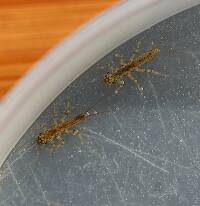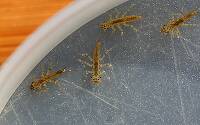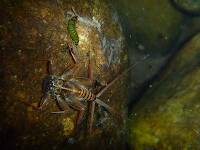
Hex Mayflies
Hexagenia limbata
The famous nocturnal Hex hatch of the Midwest (and a few other lucky locations) stirs to the surface mythically large brown trout that only touch streamers for the rest of the year.
Featured on the forum

Some characteristics from the microscope images for the tentative species id: The postero-lateral projections are found only on segment 9, not segment 8. Based on the key in Jacobus et al. (2014), it appears to key to Neoleptophlebia adoptiva or Neoleptophlebia heteronea, same as this specimen with pretty different abdominal markings. However, distinguishing between those calls for comparing the lengths of the second and third segment of the labial palp, and this one (like the other one) only seems to have two segments. So I'm stuck on them both. It's likely that the fact that they're immature nymphs stymies identification in some important way.

Troutnut is a project started in 2003 by salmonid ecologist Jason "Troutnut" Neuswanger to help anglers and
fly tyers unabashedly embrace the entomological side of the sport. Learn more about Troutnut or
support the project for an enhanced experience here.
Martinlf on Apr 30, 2007April 30th, 2007, 10:12 am EDT
Seining in a spring creek not too far from home on Sunday I found abundant caddis larva, descriptions of which do not appear in LaFontaine's book or in the Orvis Caddisfly handbook, as far as I can tell. I also checked the Aquatic Insects section on this forum, but didn't come across anything like them. They appear to be free living, and the general body shape, segmented, plump, and tapered at both ends, was much like Rhyacophilidae, but the bugs I found lack any plates behind the tiny head, which is light brown and comes to point, much like the end of a sharp toothpick. There is a dark V at the tip of the point, with the widest part at the tip, looking somewhat like it might be the outline of jaws, but I lack sufficient magnification in any of my instruments to really tell. The one I brought home was 15 mm, but there were larger and smaller specimens. The dorsal side was two tone, each segment cream on the front and very dark grey on the back, giving the dorsal side a distinct dark and light banding. The ventral side was cream. It had what appear to be two hooks at the tail. It did have six legs up front, so it appears to be a caddis, not some other bug--unless some beetles have aquatic larvae that look like this, I suppose.
Does anyone have any ideas about what this might be, and more importantly, might it be a good thing to imitate for a searching pattern in this stream, or is this bug generally unavailable for trout?
I am thinking alternating bands of black and white micro chenille, or perhaps embroidery floss, might work in an imitation, Or I might try cutting a Tyvek overbody, coloring it, and binding it to a white chenille underbody with a spiral of white thread to create segments and realistic looking dorsal and ventral surfaces--but if someone knows this bug and has a pattern, I'd be most interested.
Does anyone have any ideas about what this might be, and more importantly, might it be a good thing to imitate for a searching pattern in this stream, or is this bug generally unavailable for trout?
I am thinking alternating bands of black and white micro chenille, or perhaps embroidery floss, might work in an imitation, Or I might try cutting a Tyvek overbody, coloring it, and binding it to a white chenille underbody with a spiral of white thread to create segments and realistic looking dorsal and ventral surfaces--but if someone knows this bug and has a pattern, I'd be most interested.
"He spread them a yard and a half. 'And every one that got away is this big.'"
--Fred Chappell
--Fred Chappell
Taxon on Apr 30, 2007April 30th, 2007, 11:57 am EDT
Martinlf on Apr 30, 2007April 30th, 2007, 12:39 pm EDT
Roger, I had forgotten that I have a small plastic jeweler's loupe in my vest, and using it I determined that the head actually does look much like the one in your photo. I could make out the tiny black eyes, at least, next to the dark v marking. I'm used to seeing the easily visible distinct plates of the Rhyacophilidae. My bug has such a small head capsule I guess I didn't see the plate. Now, if I may be forgiven for getting right down to practical matters, do you know what this thing is, and whether or not an imitation can be fished successfully?
"He spread them a yard and a half. 'And every one that got away is this big.'"
--Fred Chappell
--Fred Chappell
Taxon on Apr 30, 2007April 30th, 2007, 2:17 pm EDT
Martin-
The head capsule pictured above is of Rhyacophila arnaudi, a species we have in the western coastal states. It is from my Xerces Society CD. However, the following (17) Rhyacophila species are present in Pennsysvania, and I suspect it may be one of them:
Rhyacophila atrata
Rhyacophila banksi
Rhyacophila brunnea
Rhyacophila carolina
Rhyacophila carpenteri
Rhyacophila formosa
Rhyacophila fuscula
Rhyacophila glaberrima
Rhyacophila invaria
Rhyacophila ledra
Rhyacophila lobifera
Rhyacophila mainensis
Rhyacophila manistee
Rhyacophila nigrita
Rhyacophila otica
Rhyacophila torva
Rhyacophila vibox
The head capsule pictured above is of Rhyacophila arnaudi, a species we have in the western coastal states. It is from my Xerces Society CD. However, the following (17) Rhyacophila species are present in Pennsysvania, and I suspect it may be one of them:
Rhyacophila atrata
Rhyacophila banksi
Rhyacophila brunnea
Rhyacophila carolina
Rhyacophila carpenteri
Rhyacophila formosa
Rhyacophila fuscula
Rhyacophila glaberrima
Rhyacophila invaria
Rhyacophila ledra
Rhyacophila lobifera
Rhyacophila mainensis
Rhyacophila manistee
Rhyacophila nigrita
Rhyacophila otica
Rhyacophila torva
Rhyacophila vibox
Quillgordon on Apr 30, 2007April 30th, 2007, 3:25 pm EDT
Louis/Roger,
R.torva is the only one listed for Lebanon County.
R.mainensis " " " " " Dauphin County.
Ref: Penn St.(Eire).........
link here
John
R.torva is the only one listed for Lebanon County.
R.mainensis " " " " " Dauphin County.
Ref: Penn St.(Eire).........
link here
John
Flyfishing is a state of mind! .............. Q.g.
C/R........barbless
C/R........barbless
Martinlf on Apr 30, 2007April 30th, 2007, 4:33 pm EDT
Roger, I was under the seemingly mistaken impression that Rhyacophilidae were green, hence the common name name Green Rock Worm. So they come in other colors? John, I actually wasn't in Dauphin County but northwest of there.
"He spread them a yard and a half. 'And every one that got away is this big.'"
--Fred Chappell
--Fred Chappell
Taxon on Apr 30, 2007April 30th, 2007, 5:24 pm EDT
Roger, I was under the seemingly mistaken impression that Rhyacophilidae were green, hence the common name name Green Rock Worm. So they come in other colors?
Louis-
Color is really not a very reliable character. I believe Rhyacophila larvae are generally green, often vividly so, but vary from light tan to bright green, depending on species and (perhaps) environmental factors. Here is a photo of Rhyacophila mainensis, the color of which may (or may not) have been impacted by preservative.

Quillgordon on May 1, 2007May 1st, 2007, 1:00 am EDT
Louis,
OK..... you said you were close to home, so I assumed it was one or the other. I included the map; not sure if you have it 'bookmarked'.
Color.... I also thought they were all green......
Fishing technique.... Hafele and LaFontaine both state the 'artifical' s/b fished in fast water, because this is where the larva habitate.
John....
OK..... you said you were close to home, so I assumed it was one or the other. I included the map; not sure if you have it 'bookmarked'.
Color.... I also thought they were all green......
Fishing technique.... Hafele and LaFontaine both state the 'artifical' s/b fished in fast water, because this is where the larva habitate.
John....
Flyfishing is a state of mind! .............. Q.g.
C/R........barbless
C/R........barbless
Martinlf on May 1, 2007May 1st, 2007, 1:43 am EDT
Roger, your bug looks a lot like the one I found. I'm assuming that it may be a very useful pattern, since fish take green rock worms readily. Now I'll try a zebra rock worm. Thanks for all the help; you too, Quillgordon. I'll take a look at Hafele's book. Oh, Roger, what we Tennesseans call Virginia Bluebells were blooming where I was seining, simply gorgeous. Wordsworth writes, "To me the meanest flower that blows can give Thoughts that do often lie too deep for tears. --"Ode: Intimations of Immortality from Recollections of Early Childhood", 1803. I realized what he meant when I saw them. Caught a couple of fish too, but seining and the flowers were as much a part of the beautiful day as the fishing. I'm working toward a great/skunked day when it comes.
"He spread them a yard and a half. 'And every one that got away is this big.'"
--Fred Chappell
--Fred Chappell
Quick Reply
Related Discussions
Topic
Replies
Last Reply
0
Jun 11, 2023
by Fishohio614
by Fishohio614
Acroneuria specimen moved from genus to species level
In Acroneuria carolinensis Stonefly Nymph by Entoman
In Acroneuria carolinensis Stonefly Nymph by Entoman
0
Mar 11, 2012
by Entoman
by Entoman
0
Apr 12, 2007
by Litobrancha
by Litobrancha
8
Mar 30, 2012
by Brookyman
by Brookyman







